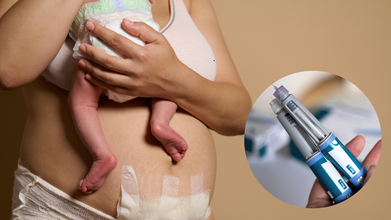- Health Conditions A-Z
- Health & Wellness
- Nutrition
- Fitness
- Health News
- Ayurveda
- Videos
- Medicine A-Z
- Parenting
How Antimicrobial Resistance Threatens Neonatal Mortality Rates Globally

How Antimicrobial Resistance Threatens Neonatal Mortality Rates Globally
Neonatal mortality remains a major health challenge across the world, which involves neonatal sepsis and other related factors of prematurity. Though many strides have been done in reducing NMR, there is a need for more appropriate interventions and strategies directed towards addressing the rise in the escalation of AMR. Combating AMR will be critical in improving neonatal survival rates while giving each newborn a healthier start into life globally.
The newborn period is the key period for infant health, and the first 28 days of life are critically important-both for survival and as a base to set lifetime health and development. Neonatal deaths globally have witnessed a significant decline over the past couple of decades. The neonatal mortality count has significantly reduced dropping from a high of 5 million in 1990 to as low as 2.3 million as of 2022. However, this decline notwithstanding, neonatal mortality is still staggeringly high across low-and middle-income nations.
Neonatal mortality rates are 22 per 1000 live births in India. Neonatal sepsis and prematurity are the main causes of neonatal deaths in these tragic events. Recognizing the gravity of the issue the Indian government started the Indian Newborn Action Plan (INAP) in 2014. The goal is to take NMR down to the single digits by 2030. This initiative has brought in several key interventions, including antenatal care (vaccines, micronutrient supplementation), skilled birth attendance, clean birth practices, and neonatal resuscitation techniques. More promisingly, postnatal interventions, including early initiation of breastfeeding and skin-to-skin contact, have been proven to work well in improving newborn survival rates.
Despite these improvements, one of the biggest concerns in neonatal care today is the growing problem of antimicrobial resistance (AMR) which seriously threatens efforts to reduce neonatal mortality.
What is Antimicrobial Resistance?
Antimicrobial resistance occurs when microorganisms such as bacteria, viruses and fungi evolve over time and become resistant to commonly used antibiotics and other medications. This resistance makes infections more difficult to treat, increasing the risk of mortality and complicating treatment options. The World Health Organization has classified AMR as one of the most urgent global health threats since it not only causes death and disability but also places immense pressure on healthcare systems, significantly raising the economic burden.
The sources of AMR are many, including poor hygiene and infection control in healthcare settings, overuse and misuse of antibiotics. Contributing factors to this rapidly growing problem are antibiotic prescriptions for patient needs that do not require them and failure to complete antibiotic courses, as prescribed.
AMR and Newborn Health
For neonates, the risk is much more vital for AMR. Neonates are particularly prone to developing infections due to their rather weak immune systems. Neonatal sepsis, severe bacterial infection, is one of the leading causes of neonate deaths and it often manifests complications when it is because of drug-resistant pathogens.
According to Dr. Apoorva Taduri, Consultant Neonatologist, "Neonatal sepsis accounts for a significant proportion of neonatal deaths, and AMR is making it worse. MDR pathogens cause around 30% of neonatal sepsis mortality globally.
Maternal health and care are also factors influencing AMR in neonates. Over-prescription of antibiotics during pregnancy increases the risk of neonatal sepsis and the development of multi-drug-resistant pathogens in newborns. This calls for prudent use of antibiotics during pregnancy and at the time of delivery. In fact, studies indicate that indiscriminate use of antibiotics in mothers has a direct impact on neonatal health, which may eventually lead to resistant infections in newborns.
One of the major issues is that the drug-resistant bacteria are causing an increasing number of healthcare-associated infections in the neonatal care settings, which include NICUs. Infections by such bacteria prove to be challenging to treat; they require more advanced, expensive interventions, and the period of risk of mortality and morbidity is extended.
Counteracting AMR in Neonatal Care
To combat AMR and reduce neonatal mortality a multifaceted approach is necessary. Dr. Taduri emphasizes the continuation of the strategies outlined by the Indian Newborn Action Plan (INAP), specifically in reducing neonatal sepsis and improving infection control. However, to combat AMR more must be done to ensure proper use of antibiotics in both maternal and neonatal care settings.
Key strategies for reducing AMR in neonatal care are:
1. Improving Infection Prevention Practice: This implies, therefore, that more efforts would be made regarding stricter hospital hygiene standards, strict equipment sterilization after its usage and even maintaining adequate hand hygiene. Enhanced infection control practices greatly impact minimizing AMR pathogens distribution.
2. Antibiotic Stewardship- Teaching the healthcare providers how not to use antibiotics is a crucial thing in preventing overuse prescription. Antibiotic stewardship programs are designed to promote use of antibiotics only when truly required; appropriate drug, dose and length of treatment should be taken.
3. Improved access to WASH: Access to clean water and sanitation is a fundamental aspect of preventing infections in mothers and newborns. WASH interventions such as clean birthing practices, can reduce the risk of neonatal sepsis due to unsanitary conditions.
4. Maternal Health Strengthening: Proper maternal care, such as proper vaccination, antenatal steroids, and supplementation of micronutrients, can reduce the risk of prematurity and neonatal infection. Prevention of infection in mothers is the first step towards prevention of infection in newborns.
5. Early Diagnosis and Treatment: Early identification and treatment of neonatal infections are very important. This includes proper screening for sepsis and the use of appropriate antibiotics based on the local resistance patterns. It also involves ensuring that infants receive adequate neonatal care, such as those provided in Special Newborn Care Units (SNCUs).
The rise of antimicrobial resistance is a global health challenge that requires urgent action. Combating AMR requires a coordinated effort from governments, healthcare systems and communities worldwide. In neonatal care, addressing AMR is essential to further reducing neonatal mortality rates and ensuring that every newborn has the opportunity to thrive.
As Dr. Taduri concludes, "While we have made substantial progress in reducing neonatal mortality, the emerging risk of antimicrobial resistance creates a major challenge for our efforts. Combating AMR requires a global collective effort, with priorities on infection prevention, responsible use of antibiotics, and enhancement of healthcare practices to ensure a healthier future for all newborns."
Dr Apoorva Taduri is a Consultant Neonatologist at Fernandez Hospital
Older, Younger or Middle Child: Does Birth Order Shape Your Personality?

Credits: iStock
Are you a younger sibling in your family and you relate to other younger siblings? Do you feel some of your habits and traits match other younger siblings? Or are you the middle child and you feel that sometimes you are excluded. When you talk about it, other middle children also agree with you. If this is the case with you, then you may be interested to know the Birth Order Theory.
This theory was developed by Alfred Adler in 1964, who focused on the importance of birth order on personality development. In this theory, he says that though children may be born into the same household, their birth order greatly influence their psychological development.
As per Adler's birth order theory, a child could have certain personality traits which are as followed:
- The Oldest Child: more authoritarian, and feels powerful due to high expectations set by the parents
- The Youngest Child: treated like a spoiled baby and cannot rise above the other siblings
- The Middle Child: even tempered, but has trouble fitting in as they have always been sandwiched between the younger and the older siblings
However, for middle child, their characteristics would often get itself a term, called the Middle Child Syndrome.
What Exactly Is A Middle Child Syndrome And What Sets Them Apart From Their Younger And Older Siblings?
Middle child syndrome is the belief that middle children are excluded, ignored, and neglected because of their birth orders.
People often talk about “middle child syndrome,” the idea that the child who is neither the oldest nor the youngest develops a very particular personality. While some of this comes from family dynamics rather than science, many families do notice certain patterns.
Personality Traits
Middle children sometimes feel overshadowed by their siblings. The oldest is often seen as responsible and strong-willed, while the youngest gets extra attention for simply being the baby of the family. The middle child may end up somewhere in the middle of all this, which can make them quieter, more even tempered, and sometimes unsure of where they fit in.
Family Relationships
When it comes to parents, middle children might feel that they do not get the same level of attention as their siblings. The older child usually carries more responsibility, and the younger child often gets extra care and protection. The middle child may feel they slip through the cracks and receive less one-on-one time with their parents.
Sibling Rivalry
Feeling unseen can spark a sense of competition. Many middle children find themselves competing for attention from both parents and siblings. At the same time, they often become the peacemaker of the family simply because they are used to being in the middle of everything.
Feeling Left Out of Favoritism
When parents unintentionally favor the oldest for their achievements or the youngest for their sweetness, the middle child may feel they are no one’s first pick. They are not the trailblazer or the baby, and this can shape how they see their place in the family.
Carrying These Feelings Into Adulthood
Some people believe that these early experiences can follow middle children into adulthood. If a middle child grew up feeling overlooked, they might struggle with co dependency or constantly try to keep the peace in relationships. They may also find it difficult to believe they can be someone’s closest friend or favorite person.
Their personalities often seem muted when it is compared to the other siblings, this is because they have always blended into the background. These patterns can show up at work, in friendships, and in romantic relationships.
What Research Actually Shows
Although middle child syndrome is talked about a lot, scientific research has not clearly confirmed it. There have been studies that show some truth to the theories, while others deny. Some research suggests that middle children do feel less close to their parents or are less likely to turn to their parents when they are going through stressful times in their lives. A 2019 study showed that middle children were less likely to feel comfortable talking to their parents on topics like sex education. Though it is important to note that this is a broad topic to begin with, and could have cultural variations.
Other studies have suggested they might be less family oriented or more prone to certain perfectionistic traits. But these findings are not consistent across research. In fact, a number of large studies show no strong link between birth order and major personality traits such as extraversion, emotional stability, or agreeableness.
Some studies even contradict each other entirely. For instance, one study suggested middle children might have a higher risk of depression, while another found that oldest children were more likely to experience mental health issues.
So Does Middle Child Syndrome Exist?
With so many conflicting findings, scientists cannot say for sure. Many experts believe that personality is shaped by a mix of family environment, parenting styles, cultural background, and individual temperament. Birth order may play a small role, but it is unlikely to be the determining factor.
In short, middle child syndrome is more of a popular idea than a proven scientific fact. Each child’s experience is unique, and many different influences shape who we become.
More New Moms Turning to Ozempic After Birth, But Experts Are Worried

Credits: iStock
Danish researchers were studying the use of medicines on women during and after pregnancy. What they realized is that number of women consuming Ozempic and Wegovy after childbirth has increased. As per their observation, in 2018, less than 5 prescriptions for every 10,000 women post six months of their childbirth were there. However, this number increased to 34 in mid-2022, and by mid-2024, there were 173 prescriptions.
That comes close to 2 percent of all postpartum women. Most of these women were in their 30s, had more than one child, and while many were overweight, they did not have diabetes. They also had no previous history of using GLP-1 medications.
This spike surprised researchers because the postpartum phase is usually a time when the body naturally sheds some pregnancy weight and undergoes major hormonal changes. “In a period characterized by natural weight loss and marked hormonal change, this was unexpected,” said Mette Bliddal, a pharmacologist at the University of Southern Denmark and the study’s first author, as reported by the New York Times. The findings were published in JAMA.
How Was The Study Conducted?
The analysis reviewed 382,277 pregnancies in Denmark from early 2018 through June 2024. Researchers used national health registries to track every live birth and every prescription filled for GLP-1 drugs during the postpartum period. This made it possible to see the rise in real time.
Although semaglutide, the ingredient in Ozempic and Wegovy, is widely used for weight loss, its safety in the months after childbirth is still unclear. This is a time when many mothers are breastfeeding and adjusting to changing hormone levels, sleep disruptions, and recovery from pregnancy.
What We Know and Don’t Know About Breastfeeding Safety
Right now, evidence around the safety of GLP-1 drugs for breastfeeding mothers is very limited. While semaglutide has not been detected in measurable amounts in breast milk and no immediate negative effects have been seen in infants, researchers caution that long-term effects on a baby’s metabolism, growth, or pancreas remain unknown.
Major medical groups are also hesitant to give a firm recommendation. The American College of Obstetricians and Gynecologists has not released guidelines because the drugs are too new and the data isn’t strong enough. First Exposure, a Canadian research network that evaluates drug safety in pregnancy and breastfeeding, advises against using these medications while breastfeeding. They also recommend stopping them one to two months before trying to conceive.
Experts say the caution comes from the lack of solid research. GLP-1 drugs are large molecules that usually do not transfer easily into breast milk and would likely break down in a baby’s stomach. Still, the uncertainty is significant enough that researchers prefer mothers avoid them during breastfeeding.
Why Researchers Are Concerned
Another concern is that these appetite-suppressing medications could affect milk production, nutrient content, or even leave mothers dehydrated. Dr. Bliddal noted that the postpartum period is a time when “the body is working hard to regain its balance.” Without knowing how weight loss drugs interact with these processes, many specialists believe it is safer to avoid them until more is known.
Even small changes in breast milk composition could matter for infant development. Since there is no clear data on how GLP-1 drugs might alter fat content or nutrients in breast milk, researchers urge caution.
Vanessa Hudgens Becomes Mother Again At 36; Is Late Pregnancy Safe For Women?

Credits: Instagram
Vanessa Hudgens at the age of 36 is a mother again. She welcomed her second baby with husband Cole Tucker. The news was announced on Instagram on Saturday, where she shared a photo of herself lying in a hospital bed, holding Tucker's hand.
She wrote: "Well…. I did it. Had another baby!! What a wild ride labor is. Big shout out to all the moms. It’s truly incredible what our bodies can do ❤️."
This month itself, Catherine Paiz revealed that she was pregnant with her fourth baby at the age of 35.
These news of celebrity pregnancy after 30 spark the spotlight on late motherhood and how safe it really is?
What Does The Data Tell Us On The Trend Of Late Motherhood?
The average age of mothers in the US have continued to rise, a new report released on June 13 by the National Vital Statistic System (NVSS), provides the shift in age trends between 2016 and 2023. The study, conducted by Andrea D. Brown, Ph.D., M.P.H., and her colleagues at the National Center for Health Statistics.
The researchers found a clear increase in the mean age of mothers at the time of their first birth. In 2016, the average age of a first-time mother was 26.6 years. By 2023, this had risen to 27.5 years — nearly a full year’s difference in just seven years.
But the trend isn’t limited to first-time mothers. In Paiz's case, she is having her fourth child at 35.
Is Late Pregnancy Healthy?
The National Institute of Health (NIH), US (2022), 20% of women in the US are now having their first child after the age of 35. While it is the new trend, the NIH doctor Dr Alan Decherney, a fertility expert explains that "As women age, they are still fertile, but their odds of pregnancy are decreased because they are not making as many good eggs that will fertile and divide normally and turn out to be an embryo."
After age 30, a woman's fertility decreases ever year, notes the NIH July 2022 issue. It notes: "The number and quality of her eggs goes down until she reaches menopause."
However, experts do point out that getting pregnant in your 30s need not be a stressful affair at all times. As it is at this age when you experience more stability, and also someone you know who have a personal experience in handling one. Most important, you are more mature at this age, which you may not be in your 20s.
What Must You Keep In Mind If You Plan Pregnancy After 30?
Quit Habits: If you are a smoker, or consume alcohol, this is a good time to leave it.
Reduce Stress: While pregnancy for some can bring stress, try to find activities that help you release it.
Healthy Weight: Ensure that your weight is right, reduce your waist to bring it to a healthy range for a healthy pregnancy.
Food Habits: Stop eating junk and start eating more whole grains.
Exercise: A sedentary lifestyle can impact negatively on the child. You do not have to do HIIT, however, regular easy workouts can make both the pregnancy and delivery easy.
Dr Michelle Y Owens, professor of obstetrics and gynecology and a practicing maternal-fetal medicine specialist at the University of Mississippi Medical Center in Jackson, writes for the American College of Obstetricians and Gynecologists (ACOG) that "the longer your eggs have been around, the more likely they are to produce a pregnancy with a chromosome problem that can lead to a condition like Down syndrome. The risk goes up significantly after 35." However, she says, there is a good news. Now, we have tools to detect and respond to pregnancy complications early.
© 2024 Bennett, Coleman & Company Limited

